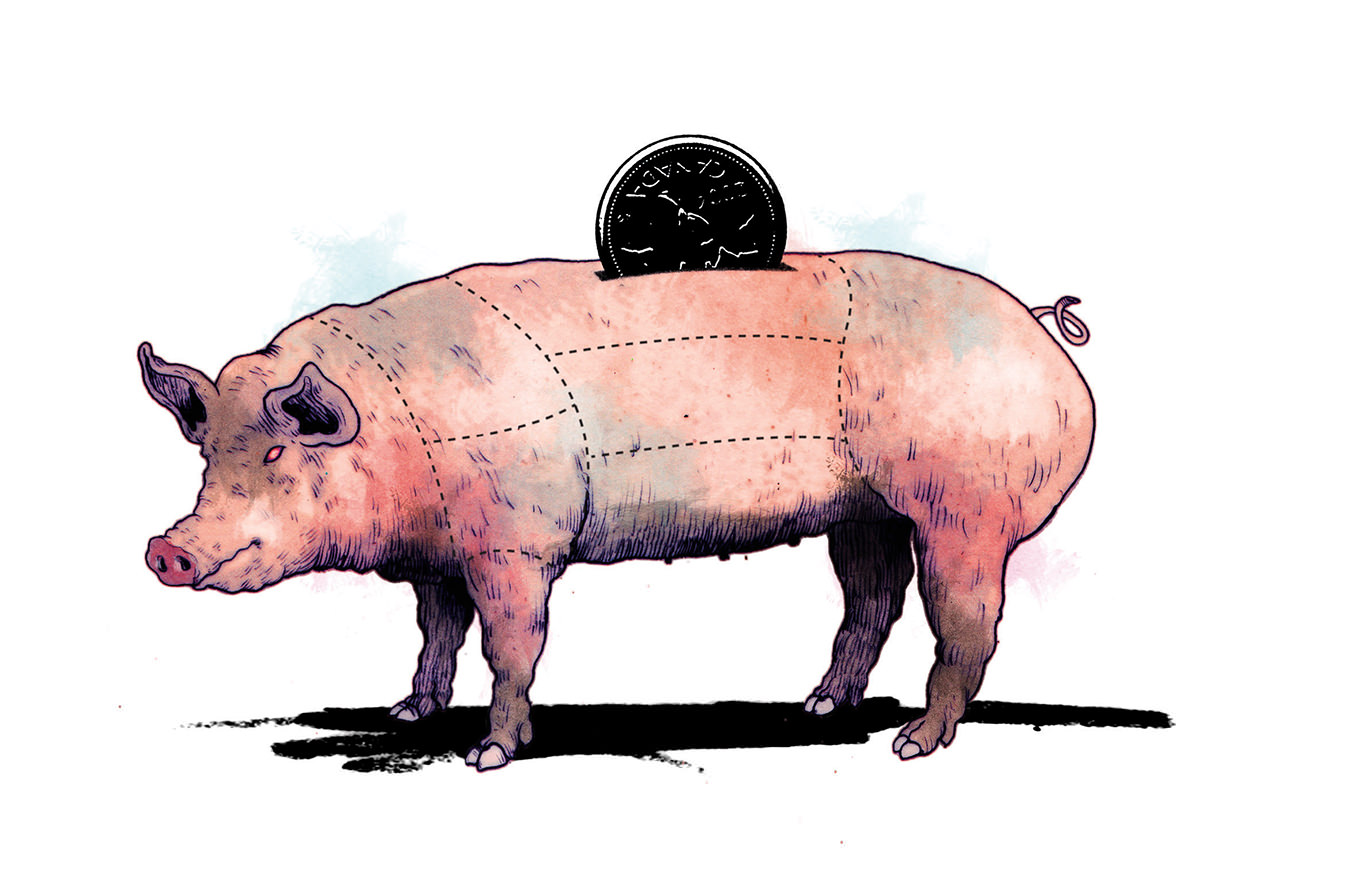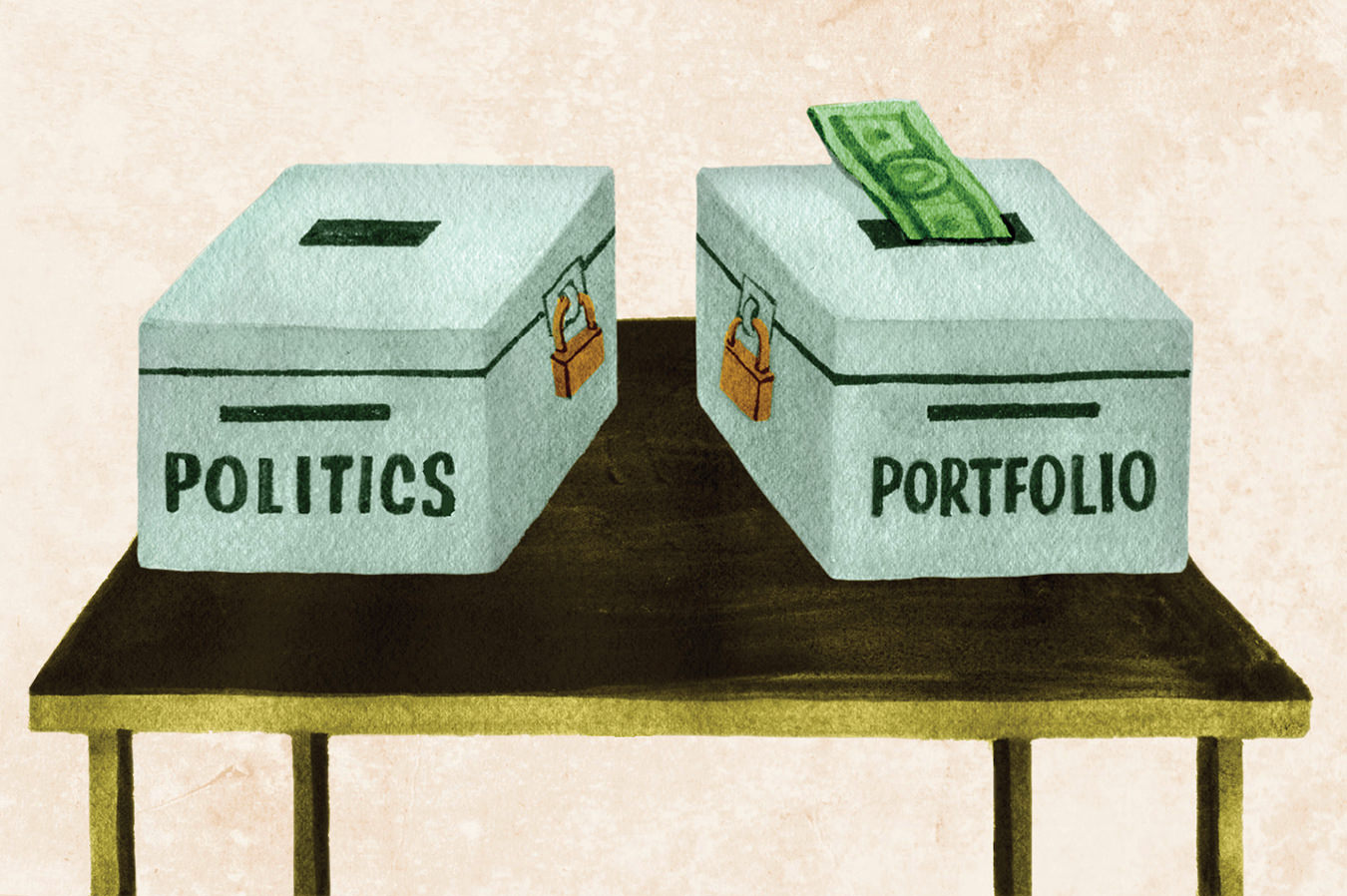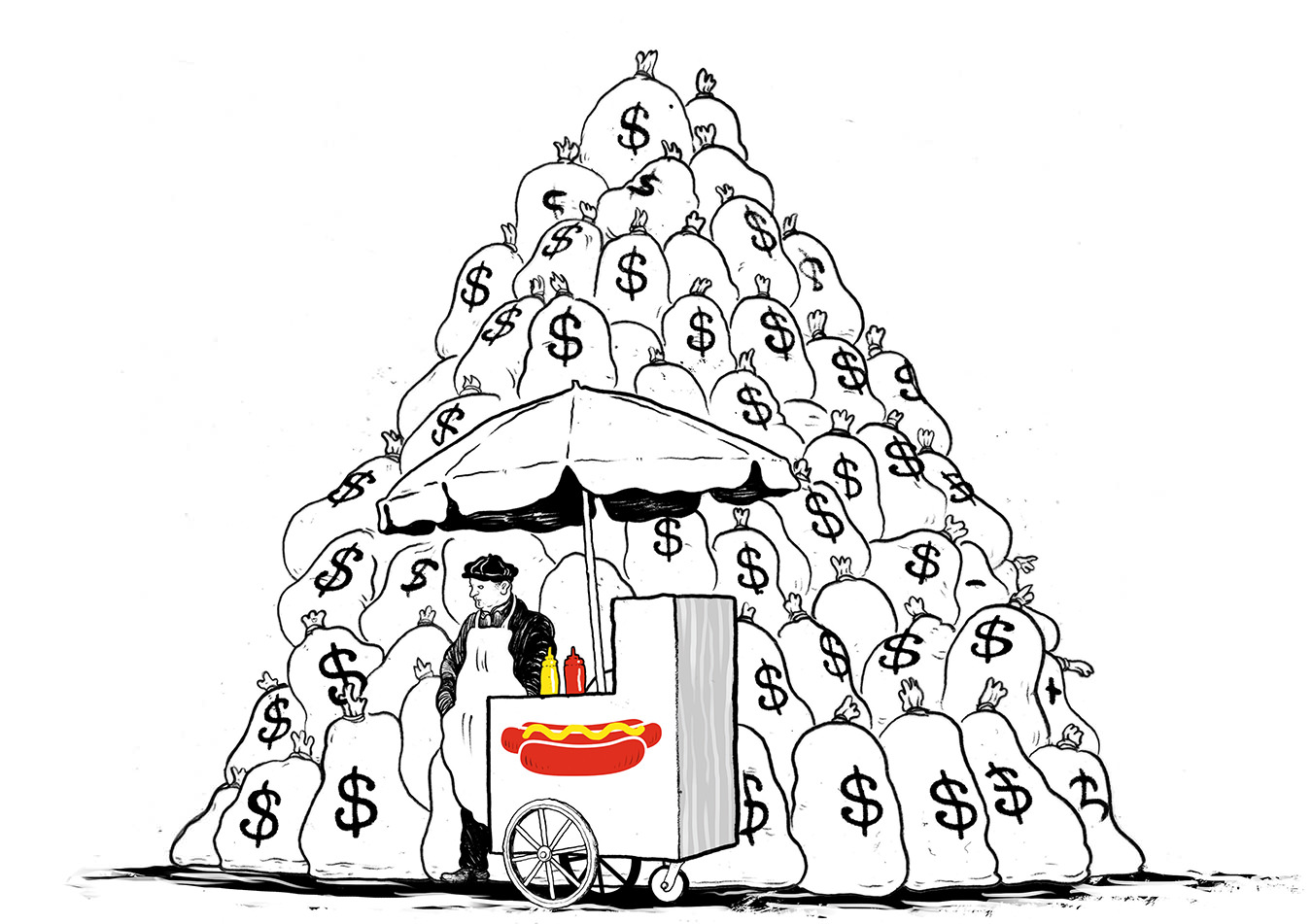The Economics of Investing in Food
Food for thought.

Illustration by David Foldvari.
Here’s a little investment project for you: Go to your local supermarket and pick up some groceries—a loaf of bread, a litre of milk, a bottle of ketchup, a half-pound of French roast—doesn’t really matter what. Put it in your basket and proceed to the nearest checkout.
Here’s where things get interesting: Keep your eye on the register as your cashier rings up your groceries. Notice something? That’s right: you’re paying more than you used to for everything that passes by the bar code scanner. And that, dear reader, could very well be the best investment idea you’re likely to hear over the next decade.
To put it plainly, the price of food is going up. A lot. In fact, the United Nations’ Food and Agriculture Organization (FAO) Food Price Index, a monthly measurement of the average export prices of a representative basket of five basic groupings of food commodities (meat, dairy, cereals, oils and fats, and sugar), has increased some 139 per cent over the past eight years. Currently it’s nearly 17 per cent higher than it was during the so-called food crisis of 2008. To make matters worse, the UN predicts this is only the tip of the iceberg—or the asparagus, as it were. Over the next decade, the organization expects food prices to increase by an additional 20 to 40 per cent in real terms—that is, above and beyond whatever inflation turns out to be.
Although paying another dollar for a package of linguine isn’t likely to bring a smile to the face of your average Canadian, it also isn’t likely to force him or her into bankruptcy. Things are different in the developing world. In India, the average family spent a staggering 46 per cent of their household income on food last year. Families in China didn’t fare much better, with 33 per cent of their take-home pay going to groceries. In Canada, 13 per cent of household income is spent on food. It doesn’t take a PhD in economics to realize what kind of threat expensive food poses to emerging markets.
That threat can be measured not only in dollars, but in strife. If the experience of 2008 is any indication, expensive food can be a catalyst for riot and bedlam. That year, large-scale demonstrations gripped much of Africa and Asia, and food-related violence was blamed for hundreds of deaths throughout the world. Plus ça change: so far in 2011, rapidly escalating food prices have been blamed for riots and demonstrations in Tunisia, Algeria, and Mozambique. Whether the political order can control the unrest this time around remains an open question.
However nightmarish the prospect of a hungry world may be, it is a blessing for global agribusiness. Sky-high prices for wheat, soybeans, pork bellies, and other agricultural staples over the past several years have turned the family farm into a veritable cash machine. And it’s not just the guys in overalls who are getting rich. Equipment manufacturers, railroads and shipping firms, bioengineering start-ups—these are just some of the companies that stand to reap bushels of cash during the coming agricultural boom.
No doubt much of that cash will be harvested right here at home. As one of the world’s leading exporters of food and the world’s largest producer of potash, one of the three essential nutrients required by nearly all food and cash crops, Canada will almost certainly be one of the countries to profit from the growing global demand for food. Can the same be said for Canadian investors in agriculture stocks?
Betting The Farm
One investor willing to bet the farm on food is Steve Hansen. An analyst with the Vancouver office of Raymond James, Hansen has a knack for uncovering investment opportunities in the agricultural space. So much so that he was recognized by Thomson Reuters as the second-best stock picker in the country, with an overall excess return of 36.4 per cent over comparable industry benchmarks in 2010.
Hansen believes the time has come for the global agricultural industry to blossom. “This used to be a page-10 story or page-12 story,” he says. “It’s quickly migrated to [the] front page.” As Hansen goes on to explain, global agencies such as the UN are waking up to the danger of a potential food crisis, and are trying to help world governments appreciate the economic and social consequences of higher prices for basic foodstuffs. “It’s not a sleepy story anymore.”
While the phrase “perfect storm” is well worn, it remains an apt description for the confluence of supply-side and demand-side factors that have created an environment in which agriculture companies can thrive. “The sector really has started to undergo a structural change,” Hansen says. “It’s really a number of large competing secular forces—the key [word] being competing secular forces—that have driven a lot of change in what used to be a pretty sleepy sector.”
Sky-high prices for wheat, soybeans, pork bellies, and other agricultural staples over the past several years have turned the family farm into a veritable cash machine. And it’s not just the guys in overalls who are getting rich.
As Hansen explains, the forces on the demand side are well known: rapid population growth, increasing disposable income in much of the developing world, and a new appetite for protein. On the supply side, the influences are a little less obvious. As Hansen points out, over the past few years, there have been several changes to the way food is grown, produced, and shipped around the world (and for what purpose); all of these are having an undue influence on supply. Among them is a shift in diet to include more meat: “It’s really sucking out traditional grains that would be used to feed people into the animal feed space,” Hansen notes. Another is the diversion of an important food source and animal feed stock—North American corn—into the production of ethanol. “It’s a competing source of demand,” Hansen says, noting that some 36 per cent of last year’s corn crop south of the border found its way into the gas tank. “That’s really had a big influence.”
And then there is perhaps the biggest influence of all: climate change. “That’s obviously introduced a whole other series of very unpredictable factors,” Hansen says. While Hansen takes care not to pontificate on the cause of climate change, he says the fact that it’s happening is impossible to deny.
The net result is a world in which food has become an increasingly valuable resource. “The short answer is that the long-term trend is up,” says Hansen. “We think it’s an outstanding sector to be invested in. It’s got a great deal of inflation protection built into it. There are all kinds of good, structural long-term reasons you want to be invested in the sector.” But is there an ethical downside to such investment? As the cost of food rises ever higher, are agriculture investors nothing more than profiteers—making money off the misery that accompanies food scarcity? “I think that’s a difficult way to phrase it, frankly,” Hansen says. If anything, Hansen believes investors do good when they put their money to work in the companies that will improve crop yields, make farms more productive, or create an entirely new way to feed the world. “Allocating capital to the agriculture sector is going to help solve a lot of the world’s problems,” Hansen says with confidence. “It’s going to be a great facilitator of change.”
Your Money Where Your Mouth Is
Aside from grabbing a shovel and a pack of seeds, how can investors profit from the coming agricultural boom?
As Hansen points out, investors have a multitude of options when it comes to putting their money into agriculture; not all of them are created equal. In a broad sense, Hansen likes the idea of investing in “inputs”—seeds, fertilizers, and supplements farmers use to get the most out of their crop. “That’s an obvious one to me,” he says. “The fertilizer space in general, just given the supply/demand dynamics, and the control of supply that the Canadian producers tend to have, the pricing power, is a very attractive way to play it.” Hansen suggests an Exchange-Traded Fund (ETF) might be a good choice here. “For the average investor, ETFs are a great way to [invest], if [you] don’t have the time to spend on researching individual equities.”
That said, Hansen believes investors in the agricultural sector need to think beyond the big picture, and instead use a stock-selection method that focuses on companies that have fallen from the market’s grace. “You have to identify great companies with great prospects,” he says. “When they get beat up, you kind of have to plug your nose and buy them—because they’re still great companies, they’re just subject to transitory factors.”
Saskatchewan-based Alliance Grain Traders fits the bill here. “We really like small, new enterprises like [Alliance] that are sort of reinventing the agricultural space,” Hansen says. Although the world’s largest exporter of lentils and peas (the company controls about 35 to 40 per cent of global lentil exports) has a lot of good things going for it—a solid balance sheet, seasoned management, attractive opportunities for overseas expansion—an atrociously bad harvest for its main crop in 2010 has beaten down the stock, creating an attractive entry point for patient investors.
Another name that has caught Hansen’s eye is GLG Life Tech. The Vancouver-based company is one of the world’s largest producers of stevia, a herbally derived sugar substitute that’s gaining traction as a healthy, low-calorie stand-in for aspartame and other artificial sweeteners. “It’s not your traditional agriculture [stock],” Hansen says. “It’s off the radar. We really like the story, [and] it’s cheap.”
Hansen puts particular emphasis on the last word in his sentence. “Remember, great companies don’t always make great stocks,” he warns. “What you pay always dictates your return.” Important advice, considering how the fortunes of agricultural companies are often subject to the whims of both Mother Nature and hot money. “You need to be very picky about the equities you buy. While the long-term trend is up, investors need to be very vigilant. They need to be cognizant of key metrics such as valuation in different equities,” Hansen explains. “Otherwise they’ll get burned.”








